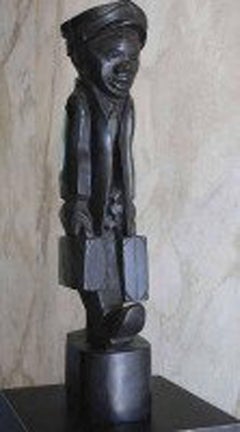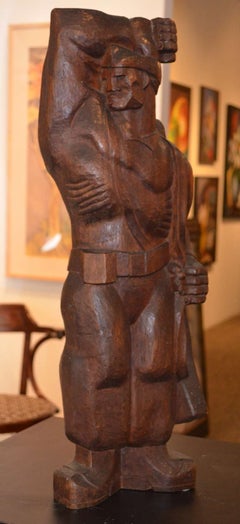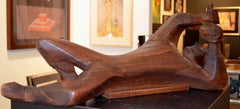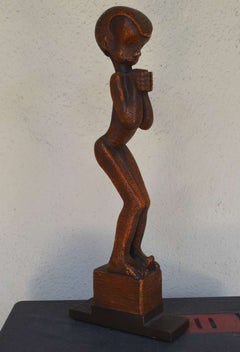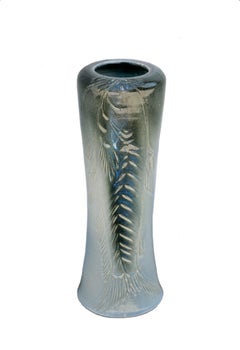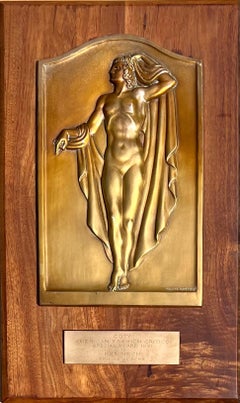Burton Freund Art
to
4
Overall Width
to
Overall Height
to
4
4
2
1
3
3
2
2
2
1
1
1
1
1
1
4
4
7,820
5,167
2,504
1,501
4
Artist: Burton Freund
Phi Beta Red Kappa
By Burton Freund
Located in West Hollywood, CA
American artist Burton Freund worked in Chicago in the 1930's and 1940’s for the FAP (Federal Arts Project) as an illustrator and sculptor.
These original wood sculptures are time capsules of the 1930's and 1940's, hand carved out of solid wood including their bases. Walking the train platform in Chicago in 1938, the artist saw a "Red Cap" porter with a Phi Beta Kappa key hanging around his neck. When asked, the porter...
Category
1930s American Modern Burton Freund Art
Materials
Wood
The Partisan
By Burton Freund
Located in West Hollywood, CA
Presenting A stunning original WPA wood sculpture by Chicago artist Burton Freund. Freund worked for the FAP(Federal Arts Project) in Chicago in the 1930's as well as an accomplished...
Category
1930s Art Deco Burton Freund Art
Materials
Wood
The Mechanic
By Burton Freund
Located in West Hollywood, CA
Presenting A stunning original WPA wood sculpture by Chicago artist Burton Freund. Freund worked for the FAP(Federal Arts Project) in Chicago in the 1930's as well as an accomplished illustrator for some of the countries leading magazines.
"The Mechanic...
Category
1930s Art Deco Burton Freund Art
Materials
Wood
Last One In!
By Burton Freund
Located in West Hollywood, CA
An original WPA wood sculpture by Chicago artist Burton Freund. Freund worked for the FAP(Federal Arts Project) in Chicago in the 1930's as well as an accomplished illustrator for so...
Category
1930s American Realist Burton Freund Art
Materials
Wood
Related Items
Blue Catfish Vase
By Sasha Makovkin
Located in Soquel, CA
A tall, modified columnar vase with incised catfish by Canadian-American ceramist Sasha Makovkin (1928-2003). Made of a white clay body. Glaze in varied shades of gray, blue and green. Signed and titled by the artist including trademark on the bottom: "Makovkin," "Blue Catfish." Dimensions: 14.25 Height x 4.75" Top x 5.13" Base.
Northern California potter Sasha Makovkin, originally from Vancouver, B.C. and of Russian descent, moved to California in 1954 to work at Heath Ceramics in Sausalito in order to get industrial experience. During the 1050s, Makovkin exhibited at the Association of San Francisco Potters and at the San Francisco Art Festivals.
Five years later after arriving in California, Makovkin took some samples of his ceramics to Gumps, a high-end department store in San Francisco. Impressed with his work, Gumps featured Makovkin’s work in the mail floor exhibits for the next three years. He had periods of apprentice with Marguerite Wildenhein at Pond Farm artists’ colony and with Ross Curtis. He also worked for Edith Heath at Heath Pottery...
Category
1990s American Modern Burton Freund Art
Materials
Ceramic, Glaze
1961 Coty Award Plaque Kenneth Hairdresser Jacqueline Onassis Bronze Fashion
Located in New York, NY
1961 Coty Award Plaque Kenneth Hairdresser Jacqueline Onassis Bronze Fashion
Bronze on wood. The wood plaque measures 12 3/4" by 20 3/4 inches. The bronze plaque itself is 13 3/4 x 8 3/4 inches and the the bronze inscription, which reads "COTY, American Fashion Critics Special Award 1961 to KENNETH of LILY DACHE...
Category
1960s American Modern Burton Freund Art
Materials
Bronze
Bronze Abstract Space Age Book Sculpture LA California Modernist Charna Rickey
By Charna Rickey
Located in Surfside, FL
Charna Rickey 1923 - 2000 Mexican-American Jewish Woman artist.
Signed Bronze House of Books, Architecture Bronze sculpture, signed Charna Rickey and on the front "House of the book." It depicts an open Torah. Original patina.
Approx. dimensions: 7 in. H x 9 in. W x 8.5 in. D. Weight: 13.1 lbs.
Modernist Judaica Sculpture
Born Charna Barsky (Charna Ysabel or Isabel Rickey Barsky) in Chihuahua, Mexico, the future artist lived in Hermosillo and immigrated to Los Angeles when she was 11. She was educated at UCLA and Cal State L.A., she married furniture retailer David Rickey and explored art while raising their three daughters. Moving through phases in terra cotta, bronze, marble and aluminum, she found success later in life. Rickey became one of the original art teachers at Everywoman's Village, a pioneering learning center for women established by three housewives in Van Nuys in 1963. She also taught sculpture at the University of Judaism from 1965 to 1981.
As Rickey became more successful, her sculptures were exhibited in such venues as Artspace Gallery in Woodland Hills and the Courtyard of Century Plaza Towers as part of a 1989 Sculpture Walk produced by the Los Angeles Arts Council. Her sculptures have also found their way into the private collections of such celebrities as Sharon Stone.
Another of Rickey's international creations originally stood at Santa Monica College. In 1985, her 12-foot-high musical sculpture shaped like the Hebrew letter "shin" was moved to the Rubin Academy of Music and Dance at Hebrew University in Jerusalem. The free standing architectural Judaic aluminum work has strings that vibrate in the wind to produce sounds. Rickey also created art pieces for the city of Brea. They commissioned some amazing art pieces by Laddie John Dill, Walter Dusenbery, Woods Davy, Rod Kagan, Pol Bury, Niki de Saint Phalle, Magdalena Abakanowicz, Larry Bell, John Okulick...
Category
20th Century American Modern Burton Freund Art
Materials
Marble, Bronze
Coming Through The Rye, Remington Bronze
By Frederic Remington
Located in Long Island City, NY
A large-scale bronze of "Coming Through The Rye", after Frederic Remington, American (1861–1909). Frederick Remington was an American painter, sculptor, and illustrator best known fo...
Category
20th Century American Realist Burton Freund Art
Materials
Bronze
Breton Wrestlers Plaster Figurative Modern Male Sculpture Female Artist LGBT WPA
Located in New York, NY
Breton Wrestlers Plaster Figurative Modern Male Sculpture Female Artist LGBT WPA
Malvina Hoffman (American, 1885 - 1966)
"Breton Wrestlers"
20 inches high
Plaster
Signed and titled BRETON WRESTLERS, PARIS, 1929
Stamped "MPI on the back of the base, likely a museum reproduction of the bronze.
The Sculpture is recorded in the Smithsonian American Art Museum's Inventories of American Painting and Sculpture database under the Control Number: IAS 9E260042.
Artist's quote about the subject:
"The wrestlers were done from actual Breton athletes, at St. Guenole – the tip end of Finistere in Brittany, France. After I saw them on the beach there I persuaded them to come to Paris where I could finish the details of the three positions and have them authenticated. This form of wrestling, I am told, is no longer permitted, as there were too many serious accidents, and sometimes broken necks."
-M. Hoffman
April 27, 1962
Born in New York City, Malvina Hoffman was a portrait sculptor of pieces that expressed the fluid movement of dancers and lofty human values. She became especially noted for her hall-of-fame portraits including Paderewski, Pavlova, Wendell Wilkie and Katharine Cornell.
Many of her pieces she carved in stone, and some of them were enormous in scale including war monuments. Her masterpiece is considered to be The Races of Man, done in 1933, commissioned by the Marshall Field Museum of Natural History in Chicago. It had one-hundred five separate pieces, cast in bronze, depicting people from diverse cultures.
She grew up in an art-oriented environment in Manhattan where her father was a pianist and music filled the house. She attended the Brearley School and took private art classes, first studying painting with John White Alexander.
Changing to sculpture, she did her first work in 1909, a portrait bust of her father who died that year leaving the family in financial straits. However, his portrait was accepted for the National Academy of Design's annual exhibition and launched her career.
She studied with Herbert Adams...
Category
1920s American Realist Burton Freund Art
Materials
Plaster
H 20 in W 6.5 in D 5.25 in
Buffalo, Silver Realist Sculpture by Arnold Goldstein
Located in Long Island City, NY
Silver cast metal sculpture of an American buffalo created by American artist Arnold Goldstein. This artwork has the signature inscribed on the belly.
Category
1970s American Modern Burton Freund Art
Materials
Metal
Hunter, Bronze and Wood Sculpture by James McCain
By James McCain
Located in Long Island City, NY
Artist: James McCain, American (b. 1944)
Title: Hunter
Year: circa 1980
Medium: Bronze Sculpture on Wooden Base, signature and numbering inscribed
Edition: 85/250
Size: 12.5 x 6 x ...
Category
1980s American Modern Burton Freund Art
Materials
Bronze
Large George Aarons Terracotta Sculpture Relief Art Deco Plaque WPA Artist
By George Aarons
Located in Surfside, FL
Two Figures (Mother and son)
9" x 17" terracotta sculpture, signed lower left mounted to wood panel, 15 1/2" x 23 1/2"
George Aarons (born Gregory Podubisky, in St. Petersburg, Russ...
Category
20th Century Art Deco Burton Freund Art
Materials
Wood, Terracotta
Plaster Sculpture Relief Art Deco Plaque WPA Artist Peace Swords to Ploughshares
By George Aarons
Located in Surfside, FL
Size includes wood mounting.
George Aarons (born Gregory Podubisky, in St. Petersburg, Russia, 1896 - died in Gloucester, Massachusetts 1980) was a distinguished sculptor who lived and taught in Gloucester, Massachusetts, for many years until his death in 1980. He had, many students in the area and he designed Gloucester's 350th Anniversary Commemorative Medal.
Aarons moved from Russia to the United States when he was ten. His father was a merchant. He began taking drawing classes during evenings at Dearborn Public School in Boston as a teenager and went on to study at the Boston Museum of Fine Arts in 1916. Aarons later moved to New York City to study with Jo Davidson, and other Paris-trained masters at the Beaux-Arts Institute. He eventually returned to the Boston area and established studios in Brookline and Gloucester, Massachusetts. During his lifetime, he was recognized internationally and won several prestigious awards. Aarons had studios in Brookline, Massachusetts and Gloucester, Massachusetts where he produced large bronze and marble figures and wood carvings. He produced several projects for the Works Progress Administration including a group of three figures for the Public Garden (Boston), a longshoreman, fisherman and foundry worker, as well as a large relief (1938) for the South Boston Housing Project and façade of the Baltimore Hebrew Congregational Building (1956).
His works are at the Museum of Art in Ein Harod, Israel; Fitchburg Art Museum in Massachusetts, Musée de St. Denis in France; Hilles Library at Radcliffe College in Cambridge, Massachusetts; and Hillel House at Boston University in Massachusetts.
He did reliefs for Siefer Hall at Brandeis University in Waltham, Massachusetts (1950); Edward Filene (the founder of Filene's Department Store and a philanthropist) on the Boston Common; Fireman's Memorial in Beverly, Massachusetts; a memorial to Mitchell Frieman in Boston; the U.S. Post Office in Ripley, Mississippi; and at the Cincinnati Telephone Building; the Combined Jewish Philanthropies building in Boston (1965); and a commemorative medal for the 350th Anniversary of the City of Gloucester, Massachusetts (1972).
Characteristic of his era, George Aarons was among the foreign-born American sculptors of the early 20th century who started their careers as academicians and evolved into modernists and increasingly abstract artists.
Over thirty pieces spanning the length of this sculptor's career were featured in this exhibition, including work in various medium bronze, wood and original plasters. Like his contemporaries, Aarons experimented with direct carving in wood, and he was one of the few academically trained sculptors who consistently cut his own works in marble. His early work was classically inspired figurative work, along with sensitive portraits. Some of his most powerful sculpture comes from his middle period, when he worked through his emotional pain following the global realization of the Jewish Holocaust. He depicted humanity deep anxiety over this tragedy with figures that are at once symbolically charged and movingly beautiful. Aarons late work consists of radically simplified forms that continue to reference the human form and often are carved directly in wood and stone.
Aarons summered and taught classes on Cape Ann for many years before moving to Gloucester full-time with his wife about 1950. While Aarons is best known locally for his domestic-scale works, he also executed numerous monumental, public commissions that can be found throughout the United States in cities such as Washington, D.C.; Baltimore, Maryland; and Cincinnati, Ohio; as well as in France and Israel.
As noted in a Gloucester Daily Times Article, Aarons wanted his sculptures to honor the struggles and nobility of people and rail against the evil done against them. And that was why, even as his work grew more and more abstract, stylized and simplified, he never left behind the form of the human figure that had been his focus from his earliest works.
Aarons told the Gloucester Daily Times in September 1954 that he found it hard to remember at just what age he started studying art, but he recalled that the nude model had to partially dress when he was in class because he was so young. He initially studied painting and drawing at the museum school, but he once said he became fascinated by sculpture when he met an established sculptor at the Copley Society in Boston who invited Aarons to his studio and offered him some clay to "play around" with.
After he graduated, he apprenticed under sculptors Richard Brooks, Robert Baker and Solon Borglum. He worked as a carpenter, shipbuilder, dishwasher and chimney sweep. He fashioned architectural decorations, including figures for fountains and now and then a few commissioned portraits. He returned to Boston by the early 1920s and began to exhibit his own works and get commissions for portraits, fountains and reliefs.
His sculptures from this time are dreamy and romantic in the realistic, academic style of the time. A painted portrait of the young Aarons that is included in the North Shore Arts Association exhibit shows a determined fellow with dark brown hair, a suit and bow tie. However, in 1922, this determined young artist was living with his parents on Calder Street in Dorchester.
In the 1930s, Aarons adopted the streamlined, monumental style of the socialist works of the time. Aarons made money, as he would all his life, from commissions, selling his personal work and teaching sculpture, but the Depression of the 1930s was tough for everyone.
So Aarons found work though the federal Works Progress Administration, one of Franklin Roosevelt's New Deal programs. He received his first major commission when he was asked to create a public sculpture for the South Boston Harbor Village public housing project around 1937. He was elevated to the position of supervisor for the project and received a corresponding $5 pay increase to make his weekly salary $32. The raise convinced him he was fit to marry and he proposed to Gertrude Band, an attractive brunette dancer whom he had been dating for more than a year. They were married before the Harbor Village project was dedicated on Labor Day 1938.
Aarons' design featured a brawny, larger-than-lifesize fisherman, longshoreman and a laborer flanked by a boy and girl at either end to portray the children who would live in the apartments. Aarons elected to do the piece in cast stone to employ carpenters and laborers as well as craftsman for a total of 10 men.
In his sculpture, Aarons focused more and more on the theme of oppressed people as he worried about the spread of fascism and Nazism during the 1930s, World War II and after. He had done pieces during the mid-1930s about the oppression of African-Americans, including "Negro Head," which is in the North Shore Art Association retrospective. After the war, he also delved into Jewish themes and became increasingly known as an important Jewish artist, leading to commissions from Jewish organizations across the country and abroad.
"He gets into raw emotion. Some people describe him as an expressionist because of the emotion (in his work)," Reynolds says.
But Aarons, also sculpted sensual sexual nudes...
Category
20th Century Art Deco Burton Freund Art
Materials
Plaster, Wood
Reclining Man Ashcan Early 20th Century American Scene Social Realism Gay Nude
By Isidore Konti
Located in New York, NY
"Reclining Man" Ashcan Early 20th Century American Scene Social Realism Gay Nude
Isadore Konti (1862 - 1938)
"Reclining Man"
7 1/2 w x 4 1/2 d x 7 high inch...
Category
1910s American Realist Burton Freund Art
Materials
Bronze
Buffalo or Bison in bronze by Charles Rumsey
By Charles Cary Rumsey
Located in Brookville, NY
Buffalo Cow by Charles Rumsey, a bronze sculpture that dates C.1910 and may be part of the preparation for the Manhattan Brie Frieze executed in 1916. ...
Category
1910s American Realist Burton Freund Art
Materials
Bronze
Czech Art Deco Carved Natural Resin Cubist Owl Bird Sculpture Joseph Martinek
Located in Surfside, FL
American sculptor Joseph Martinek was born in Chicago in 1915. He was a second generation apprentice to Auguste Rodin. He studied sculpture at the State Industrial School of Art, Pra...
Category
20th Century Art Deco Burton Freund Art
Materials
Resin, Wood
Burton Freund art for sale on 1stDibs.
Find a wide variety of authentic Burton Freund art available for sale on 1stDibs. You can also browse by medium to find art by Burton Freund in wood and more. Much of the original work by this artist or collective was created during the 1930s and is mostly associated with the Art Deco style. Not every interior allows for large Burton Freund art, so small editions measuring 9 inches across are available. Customers who are interested in this artist might also find the work of Curtis Jeré, and Stefan Traloc. Burton Freund art prices can differ depending upon medium, time period and other attributes. On 1stDibs, the price for these items starts at $30,000 and tops out at $30,000, while the average work can sell for $30,000.
